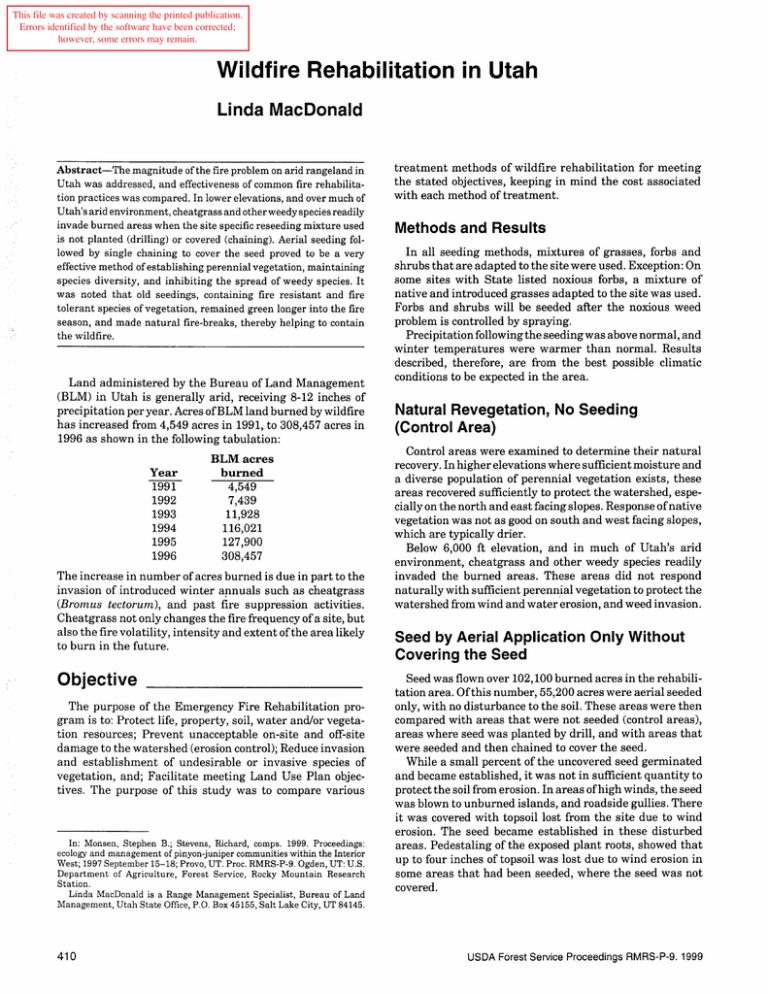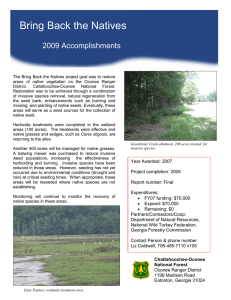Wildfire Rehabilitation in Utah Linda MacDonald
advertisement

This file was created by scanning the printed publication. Errors identified by the software have been corrected; however, some errors may remain. Wildfire Rehabilitation in Utah Linda MacDonald Abstract-The magnitude of the fire problem on arid rangeland in Utah was addressed, and effectiveness of common fire rehabilitation practices was compared. In lower elevations, and over much of Utah's arid environment, cheatgrass and other weedy species readily invade burned areas when the site specific reseeding mixture used is not planted (drilling) or covered (chaining). Aerial seeding followed by single chaining to cover the seed proved to be a very effective method of establishing perennial vegetation, maintaining species diversity, and inhibiting the spread of weedy species. It was noted that old seedings, containing fire resistant and fire tolerant species of vegetation, remained green longer into the fire season, and made natural fire-breaks, thereby helping to contain the wildfire. Land administered by the Bureau of Land Management (BLM) in Utah is generally arid, receiving 8-12 inches of precipitation per year. Acres ofBLM land burned by wildfire has increased from 4,549 acres in 1991, to 308,457 acres in 1996 as shown in the following tabulation: Year 1991 1992 1993 1994 1995 1996 BLMacres burned 4,549 7,439 11,928 116,021 127,900 308,457 The increase in number of acres burned is due in part to the invasion of introduced winter ap.nuals such as cheatgrass (Bromus tectorum), and past fire suppression activities. Cheatgrass not only changes the fire frequency of a site, but also the fire volatility, intensity and extent of the area likely to burn in the future. Objective The purpose of the Emergency Fire Rehabilitation program is to: Protect life, property, soil, water and/or vegetation resources; Prevent unacceptable on-site and off-site damage to the watershed (erosion control); Reduce invasion and establishment of undesirable or invasive species of vegetation, and; Facilitate meeting Land Use Plan objectives. The purpose of this study was to compare various In: Monsen, Stephen B.; Stevens, Richard, comps. 1999. Proceedings: ecology and management of pinyon-juniper communities within the Interior West; 1997 September 15-18; Provo, UT. Proc. RMRS-P-9. Ogden, UT: U.S. Department of Agriculture, Forest Service, Rocky Mountain Research Station. Linda MacDonald is a Range Management Specialist, Bureau of Land Management, Utah State Office, P.O. Box 45155, Salt Lake City, UT 84145. 410 treatment methods of wildfire rehabilitation for meeting the stated objectives, keeping in mind the cost associated with each method of treatment. Methods and Results In all seeding methods, mixtures of grasses, forbs and shrubs that are adapted to the site were used. Exception: On some sites with State listed noxious forbs, a mixture of native and introduced grasses adapted to the site was used. Forbs and shrubs will be seeded after the noxious weed problem is controlled by spraying. Preci pitation following the seeding was above normal, and winter temperatures were warmer than normal. Results described, therefore, are from the best possible climatic conditions to be expected in the area. Natural Revegetation, No Seeding (Control Area) Control areas were examined to determine their natural recovery. In higher elevations where sufficient moisture and a diverse population of perennial vegetation exists, these areas recovered sufficiently to protect the watershed, especially on the north and east facing slopes. Response of native vegetation was not as good on south and west facing slopes, which are typically drier. Below 6,000 ft elevation, and in much of Utah's arid environment, cheatgrass and other weedy species readily invaded the burned areas. These areas did not respond naturally with sufficient perennial vegetation to protect the watershed from wind and water erosion, and weed invasion. Seed by Aerial Application Only Without Coveri ng the Seed Seed was flown over 102,100 burned acres in the rehabilitation area. Ofthis number, 55,200 acres were aerial seeded only, with no disturbance to the soil. These areas were then compared with areas that were not seeded (control areas), areas where seed was planted by drill, and with areas that were seeded and then chained to cover the seed. While a small percent of the uncovered seed germinated and became established, it was not in sufficient quantity to protect the soil from erosion. In areas of high winds, the seed was blown to unburned islands, and roadside gullies. There it was covered with topsoil lost from the site due to wind erosion. The seed became established in these disturbed areas. Pedestaling of the exposed plant roots, showed that up to four inches of topsoil was lost due to wind erosion in some areas that had been seeded, where the seed was not covered. USDA Forest Service Proceedings RMRS-P-9. 1999 Seed by Aerial Application Followed by Chaining to Cover the Seed broadcast seeding without covering the seed was not cost effective over large areas in Utah's arid environment. The seed mixture was flown on the treatment area, followed by one-time chaining to cover the seed. In addition, in some areas, seed dribblers were placed so that shrub seeds were planted by the action of the heavy equipment in areas being chained. In 1996, some areas suitable for drilling seed were aerial seeded instead because of the vast acreage needing immediate treatment following wildfire. More than twice as many acres could be covered per day, by using this method. Covering the seed with one-time chaining, proved to be very effective in establishing perennial vegetation to protect the site from wind and water erosion. This seeding method helped establish and maintain species diversity, and inhibit the spread of cheatgrass and other- weedy species. Aerial Seeding Followed by Chaining to Cover the Seed Drill Seeding Sixteen thousand one hundred fifty acres were seeded by rangeland drills. Most exhibited a high germination response, the exception being the sand dunes at Little Sahara Recreation Area. In most cases, drilling effectively planted the seed mix, and inhibited the spread of cheatgrass and State listed noxious weeds. This method of covering the seed proved to be a very effective in establishing perennial vegetation on areas with slopes and gullies, rocky outcrops, and areas with dead tree stumps and debris. This treatment is highly effective in protecting the site from wind and water erosion. These seedings helped establish and maintain species diversity, and inhibit the spread of cheatgrass and other weedy species. Aerial seeding followed by one-time chaining to cover the seed also proved to be a practical and relatively inexpensive method to use when large acreage needs to be treated (over 300,000 acres of BLM land burned in 1996). With this method, 250 acres could be treated per day, as compared to drilling the seed at 100 acres per day. Drill Seeding Areas that were seeded by drilling had the highest germination response. But drilling could only be used on level areas free from obstacles. Therefore drilling wasn't possible in pinyon-juniper sites, rocky outcrops, and areas with washes or channels, and on slopes. Discussion __________ Study plots have been identified for long term monitoring of the treatment areas, by BLM and by the U.S. Forest Service Shrub Laboratory. Observations discussed below pertain to results of rehabilitation, the first year following treatment. Natural Revegetation In higher elevations (above 6,000 ft) where sufficient moisture and a diverse population of perennial vegetation exists, reseeding is often not needed, especially on the north and east facing slopes. However south and west facing slopes, which are typically drier, would likely benefit from seeding. Below 6,000 ft elevation, and over much of Utah's arid environment, cheatgrass and other weedy species readily invade burned areas. The dominance of cheatgrass shortens the fire cycle, and increases the volatility and extent of the fire. Also because cheatgrass does not catch and hold snow like a diverse perennial stand ofvegetation, the site becomes drier (desertification). On sites dominated by cheatgrass, the normal revegetative process is interrupted resulting in loss of native perennial species, and lack of diversity. Dense stands ofpinyon-juniper often lack a diverse understory. When wildfire removes the canopy, there is not sufficient perennial seed available in the soil to protect the site from wind and water erosion. Aerial Seeding Without Covering the Seed This method did not result in adequate perennial vegetation to protect the watershed. Invasive introduced weeds such as cheatgrass and State listed noxious weeds readily invaded the sites. In areas with highly erosive soils, wind and water erosion is evident. It was also determined aerial USDA Forest Service Proceedings RMRS-P-9. 1999 Additional Benefits of Seeding Where wildfire burned into old seedings, it's advance was slowed or stopped in that direction, in spite of strong winds. The seedings, which contain fire resistant and fire tolerant species of vegetation, remain green longer into the season. There are numerous examples where old seedings make natural fire-breaks, thereby helping to contain the wildfire. Acknowledgments The author expresses appreciation to the personnel at the BLM Fillmore Field Office who did all the on-the-ground work, and to Glenn Foreman and Kelly Rigby, Utah State Office for photographs and assistance in preparing the poster. References ___________________ Clary, Warren P. Plant density and cover response to several seeding techniques following wildfire. Research Note INT-384, 6 pp. U.S. Department of Agriculture, Forest Service, Intermountain Research Station. Everett, Richard; Clary, Warren. Fire effects and revegetatio!l on juniper-pinyon woodlands. Rangeland fire effects: a symposIUm, Boise, ID.1984November 27-29. Idaho State Office, D..S. Department of Interior, Bureau of Land Management, BOIse, Idaho. 1985. (33-37). Farmer, Mark E.; Harper, Kimball T.; Davis, James~. 19.97 .. The influence of anchor-chaining on watershed health m a Jumperpinyon woodland in central Utah. In: Ecology and management of pinyon-juniper communities within the interior west symposium; proceedings; 1997 September 15-18;. Provo, UT. Monsen, Stephen B.; Pellant, Mike. 1997. Seedmg burned shrublands by aerial broadcasting and a~ch?r chaining. 1~~7. In; E~ology and management of pinyon-Jumper commumtIes wlthm the interior west symposium; proceedings; 1997 September 15-18; Provo, UT. 411



